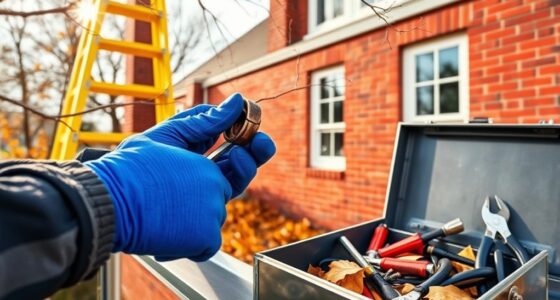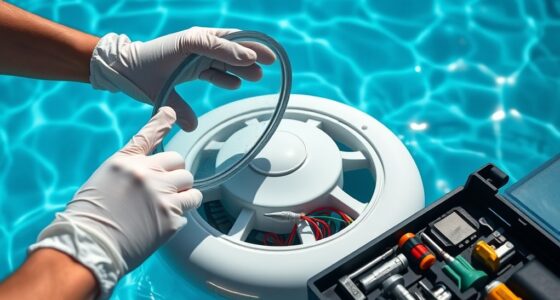You should consider replacing your automatic pool cleaner if you notice a decline in cleaning performance, frequent repairs, or obvious wear and tear like broken parts or damaged hoses. Outdated models with poor navigation or higher energy use may also be less effective. Additionally, changes in your pool’s size or increased usage can wear out your cleaner faster. Staying alert to these signs helps you maintain a sparkling pool; discover more tips below.
Key Takeaways
- Declining cleaning performance despite filter cleaning indicates it’s time for a replacement.
- Frequent repairs or broken parts suggest the cleaner has reached the end of its lifespan.
- Visible wear, tears, or damage to components point to a need for replacement.
- Outdated models with poor efficiency and lacking modern features should be upgraded.
- Changes in pool size or increased usage can necessitate a newer, more effective automatic cleaner.
Decline in Cleaning Performance
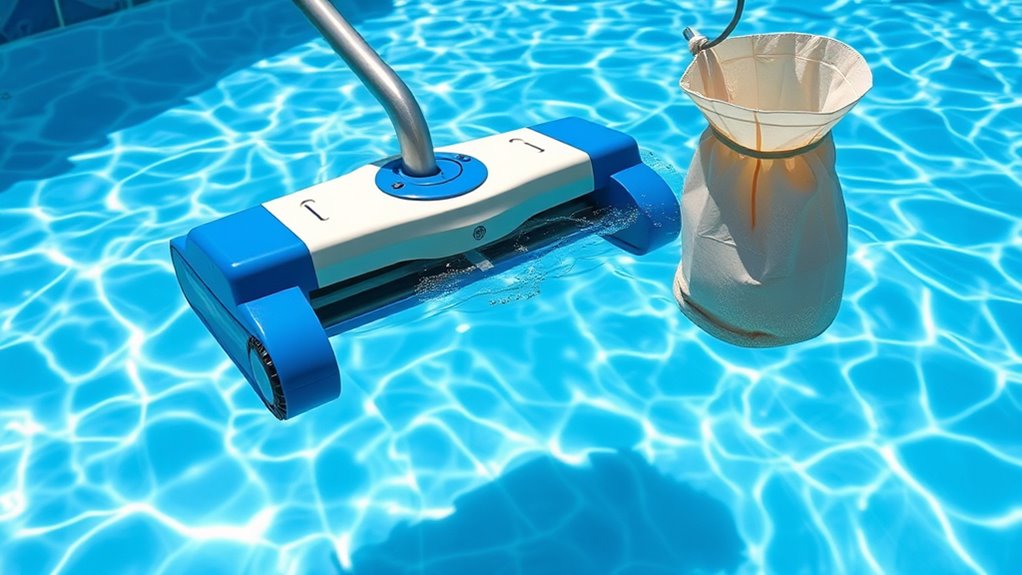
Over time, you may notice your pool cleaner isn’t picking up debris as effectively as it used to. This decline often points to reduced filter efficiency, causing debris to clog the system and hinder cleaning. When filters become dirty or worn, your cleaner struggles to trap dirt properly, leaving leaves and debris behind. Additionally, increased motor noise can signal problems; if your cleaner’s motor sounds louder or different than usual, it might be working harder or experiencing wear. These signs indicate your cleaner isn’t performing at its best. Regularly check and clean the filter, and listen for unusual motor sounds. If cleaning the filter doesn’t restore performance and noise persists, it might be time to consider replacing your pool cleaner. Proper maintenance can extend the lifespan of your automatic pool cleaner and ensure optimal performance, especially when combined with regular inspections and timely replacements. Maintaining your cleaner’s components helps prevent mechanical failure, which is often a sign that replacement is needed. Additionally, understanding the importance of filter efficiency can help you identify when your cleaner is underperforming due to system issues.
Frequent or Costly Repairs

When your pool cleaner requires frequent or costly repairs, it’s a clear sign that it’s nearing the end of its service life. Constant breakdowns can become frustrating and costly, often outweighing the expense of a new model. If you find yourself repeatedly replacing parts or paying for repairs that add up quickly, it’s time to evaluate a replacement. Costly repairs aren’t just inconvenient—they can indicate deeper issues with the mechanism or motor that aren’t worth fixing. Over time, these recurring problems diminish the cleaner’s efficiency and reliability. Recognizing these signs helps you make a smart decision before your current cleaner becomes completely unusable. Additionally, wear and tear on the parts can significantly reduce its cleaning performance and lifespan. Implementing preventative maintenance can help extend the life of your automatic pool cleaner and reduce the frequency of repairs.
Obvious Wear and Damage

Obvious wear and damage are clear signs your pool cleaner has reached the end of its lifespan. Over time, you may notice torn or frayed brushes, cracked or broken parts, or missing components. These are strong replacement indicators, showing your cleaner can no longer perform efficiently. Damaged hoses or suction leaks reduce cleaning effectiveness, forcing you to put more effort into maintenance. If the cleaner’s body is heavily scratched or warped, it’s likely past its prime. Continuing to use a worn-out cleaner can lead to further damage or incomplete cleaning, costing you more in repairs or replacements down the line. Recognizing these signs early helps you decide when it’s time to replace your pool cleaner for ideal performance and hassle-free pool maintenance. Additionally, Louisiana alimony laws may influence the financial considerations involved in replacing equipment if support or agreements are part of the divorce settlement. Being aware of pool cleaner durability can help you anticipate when a replacement might be necessary before issues become severe. Regular inspections and understanding product lifespan expectations can further assist in timely replacements, ensuring your pool stays clean and operational. Moreover, understanding the environmental conditions your pool cleaner is exposed to can help predict its longevity and performance.
Outdated Technology or Features
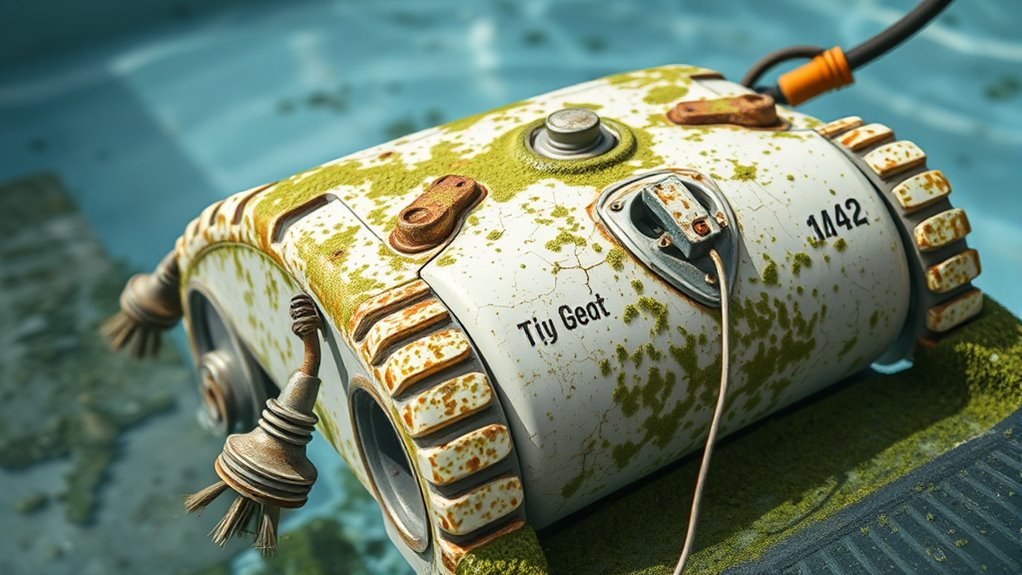
If your pool cleaner still relies on outdated technology or features, it’s a clear sign it’s time for an upgrade. Older models may lack robotic upgrades that improve navigation and cleaning efficiency, leaving spots missed and dirt lingering. They often consume more energy, making them less energy-efficient and increasing your utility bills. Modern robotic pool cleaners incorporate advanced sensors and smarter navigation, reducing cleaning time and energy use. Upgrading to a newer model can save you money in the long run by improving energy efficiency and providing a more thorough clean. If your current cleaner feels sluggish, struggles with certain pool shapes, or just doesn’t keep up, it’s time to contemplate replacing it with one that’s equipped with the latest technology. Additionally, newer models often feature waterpark amenities that enhance overall pool enjoyment and maintenance. Embracing technological advancements can further optimize your pool upkeep and provide a more seamless experience.
Changes in Pool Size or Usage
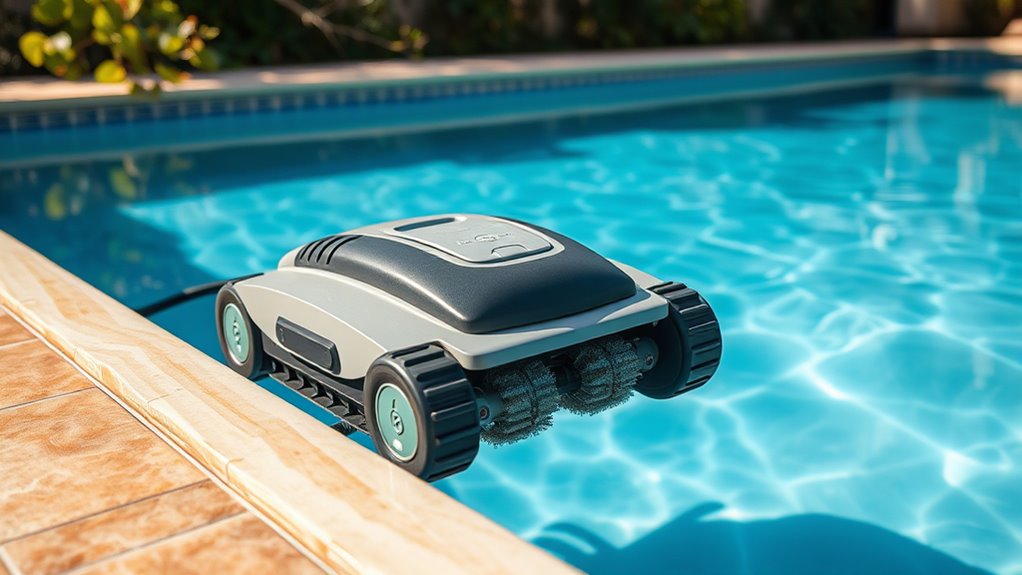
As your pool’s size or usage habits change, your current cleaner might no longer be the best fit. If you’ve made pool size adjustments, such as expanding or downsizing, your existing cleaner may struggle to cover the new area efficiently. Similarly, increased usage—like hosting more frequent parties or swimming sessions—can put extra strain on your device. Over time, this can lead to wear and reduced cleaning performance. If you notice your cleaner missing spots or needing frequent repairs, it’s a sign it’s no longer suited for your updated needs. Upgrading to a more powerful or appropriately sized model can ensure your pool stays clean without hassle. Regularly assess how changes in pool size or usage impact your cleaner’s effectiveness. Additionally, wear and tear from frequent use can diminish the cleaner’s ability to operate properly, highlighting the importance of timely replacement. Monitoring for signs of reduced efficiency, such as longer cleaning times or incomplete coverage, can help you determine when it’s time for a new cleaner to maintain optimal cleanliness and maximize cost efficiency. Incorporating a well-maintained routine can also extend the lifespan of your device and keep it performing at its best. Ensuring your cleaner has proper filtration systems can also help sustain its performance over time.
Frequently Asked Questions
How Long Should an Automatic Pool Cleaner Typically Last?
Your automatic pool cleaner usually lasts between 3 to 5 years, depending on usage and maintenance. To prolong its lifespan, keep the pool’s chemical balance ideal and guarantee it’s free of debris. Regularly check for wear and tear, and clean or replace brushes and filters as needed. Proper maintenance also boosts energy efficiency, helping your cleaner work effectively and last longer, saving you money over time.
Can a Pool Cleaner’s Performance Improve With Maintenance?
Yes, your pool cleaner’s performance can improve with proper maintenance. Regularly cleaning the pool filter guarantees peak suction and cleaning power. Inspect and replace the cable if it shows signs of wear or damage, as a faulty cable can hamper movement. Keeping these components in check helps your cleaner run smoothly, extends its lifespan, and keeps your pool sparkling clean without rushing to replace the unit prematurely.
Is It More Cost-Effective to Repair or Replace My Cleaner?
It often feels like a coin toss deciding whether to repair or replace your cleaner. When you compare costs, repair costs might seem cheaper upfront, but frequent repairs add up. A thorough cost comparison helps you see if investing in a new cleaner saves money over time. If repairs become costly or frequent, replacing your cleaner is usually more cost-effective, ensuring reliable performance and fewer unexpected expenses.
What Are Signs of Internal Component Failure?
You’ll notice signs of internal component failure in your pool cleaner through issues like internal leaks and increased motor noise. If you see water leaking inside or outside the unit, or if the motor becomes unusually loud or inconsistent, these are clear indicators something’s wrong. These problems often signal internal damage that’s hard to fix, so you might need to contemplate replacing your cleaner to guarantee ideal performance and avoid costly repairs.
How Do I Choose a New Pool Cleaner Model?
Choosing a new pool cleaner model is like finding the perfect fit for your swimming oasis. You need to take into account pool model compatibility to guarantee it works seamlessly with your pool’s size and shape. Don’t forget to check energy efficiency ratings; a more efficient model saves you money and energy. Research reviews, compare features, and select a cleaner that matches your needs for reliable, hassle-free pool maintenance.
Conclusion
Knowing when to replace your automatic pool cleaner means recognizing declining performance, costly repairs, visible wear, outdated tech, and changing pool needs. If your cleaner struggles to perform, requires frequent repairs, shows obvious damage, or no longer meets your pool’s demands, it’s time for a change. Don’t wait until it completely quits—act proactively. Maintain a clean, efficient pool by replacing your cleaner when necessary, ensuring smooth operation, peak cleanliness, and peace of mind for seasons to come.


